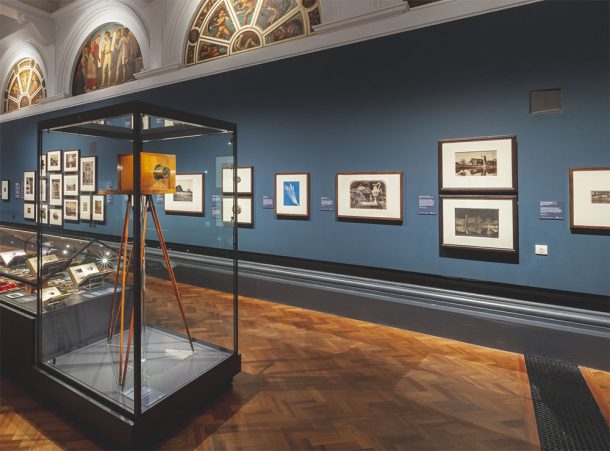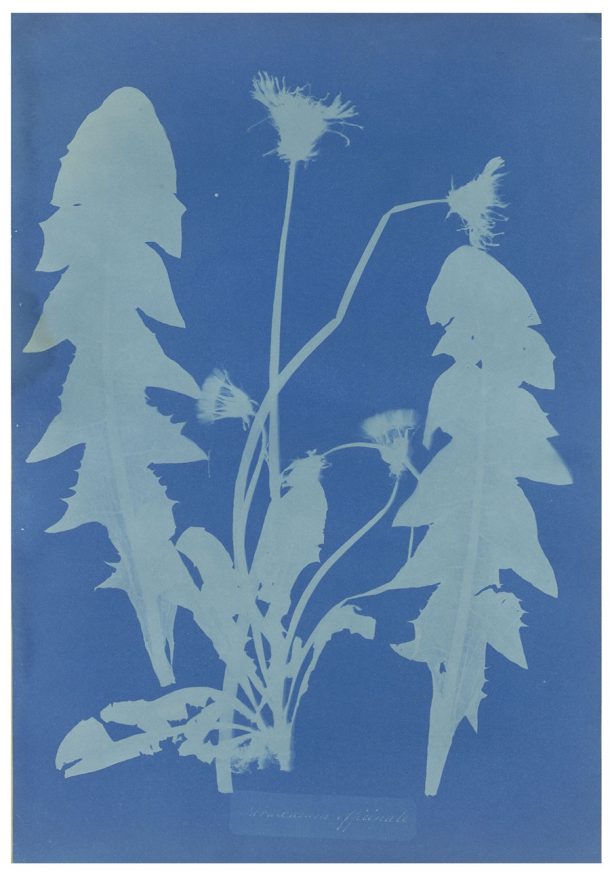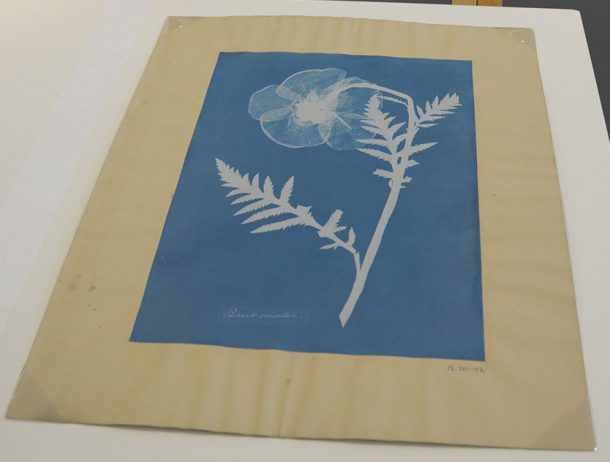In 1854 Anna Atkins created a series of images preserving nature using the cyanotype photographic process; 127 years later these rare Prussian blue images arrived at the V&A. The photographs represent Festuca ovina (fescue grasses; PH.380-1981), Taraxacum officinale (dandelion; PH.382-1981), Papaver orientale (poppy; PH381-1981) and a title page from British and Foreign Flowering Plants and Ferns (PH.379-1981).
Visiting the V&A Photography Centre opening exhibition charting photographic history in 2018, it was striking to see Atkins’s blue and white Fescue Grasses disrupting the flow of familiar sepia treasures, attracting attention and curiosity in equal measure.

I recently returned to visit the V&A Archive viewing materials relating to Atkins’s contribution to the 1984 touring exhibition The Golden Age of British Photography where once again her images added a splash of early monochromatic colour to an exhibition charting the history of British photography. The archival documents revealed the behind-the-scenes hard work of assembling, documenting, insuring, transporting and finally exhibiting images at five USA venues in collaboration with the Philadelphia Museum of Art. Detailed correspondence documents unconfined enthusiasm on both sides of the Atlantic for visitors in Philadelphia, Minneapolis, Houston, New York and Boston to be treated to a feast of early photography, including the perennial resilience of nature captured by Atkins in cameraless cyanotype photography.
Atkins chose to show diverse elements of nature, but without prioritising the exotic, expensive or rare. The V&A prints depict a humble grass, a common weed and a perennial wildflower, exhibiting equal compositional flair, labelled carefully with appropriate Latin nomenclature. The presentational style resembled her depiction of a vast collection of British seaweeds, recognising photogenic potential in common, ubiquitous natural forms, while introducing innovative botanical conservation in photographic form.

Cyanotype photography became Anna’s signature photographic process, separating her into a category of her own due to her highly skilled early use of a process discovered in 1842 by photographic pioneer Sir John Herschel. In the 1983 V&A publication A Guide to Early Photographic Processes, Brian Coe defined cyanotype as paper impregnated with iron salts, exposed to daylight to produce a Prussian blue insoluble image that was fixed by washing in water. Coe used the 1981 V&A acquisition of Fescue Grasses to illustrate the process.
Atkins privately published the first book to be illustrated using photography, Photographs of British Algae: Cyanotype Impressions before the V&A sequence of photographs. It was distributed in parts to selected recipients between 1843 and 1853. But the V&A cyanotypes are different, exceptional images created in a larger format and destined for a single recipient. The four V&A images are perhaps a visual representation of Atkins’s gratitude for the support of her lifelong close friend Anne Dixon at time of great emotional upheaval following the death of Anna’s father John George Children.
In this unique series of cyanotype botanical studies, Atkins crossed a boundary from objective scientific record into interpretive photographic art. These images become unrepresentative of their true colour, while remaining faithful to their contact-printed translucent shape and form. All are in negative, the white shadow of a poppy representing the areas of cyanotype paper unaffected by exposure to the Kent sunshine. Green leaves and yellow dandelion petals are reduced to tonal variations of white set against an unchanging Prussian blue negative space.
These photographs represent photographic contradictions – an image in white and blue but not defined as a colour photograph, each complex botanical form is reduced to cyanotype’s monochromatic uniformity. Images remain fixed in blue suspension, perfect for the representation of water-based British algae but still strangely appropriate for grass, dandelion or a poppy.
Anna Atkins’s gift to Anne Dixon demonstrated a decade of accumulated cyanotype skill, enabling the transformation of nature into timeless works of art; the images have a modern feel despite their considerable age. Anna’s photographic legacy continues to inspire a new generation of creative artists through her artistic elevation of the ordinary – a revealing negative beauty photographically replanted into a cyanotype landscape.




I am an independent researcher and have been researching and writing about Anna Atkins since 2002. It is so excellent to see the renewed interest since Professor Larry Schaaf wrote his wonderful book “Sun Gardens: Victorian Photograms by Anna Atkins. I have also taught classes to elementary schools using the process and presented talks at Art and History Museums. Learning about Anna Atkins and this process has enriched my life!